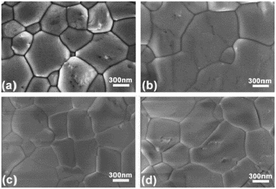CoBr2-doping-induced efficiency improvement of CsPbBr3 planar perovskite solar cells†
Abstract
Although perovskite solar cells (PSCs) have achieved the highest power conversion efficiency (PCE) of 25.2% in a very short period of development, they suffer from poor stability because the organic–inorganic hybrid perovskite materials are easily decomposed under the attacks of oxygen, moisture, heat and ultraviolet light. It is demonstrated that an all inorganic perovskite material of CsPbBr3 has excellent stability against moisture, oxygen and heat, but it has a slightly wide bandgap of 2.3 eV, which seriously hinders light absorption and leads to poor PCE. Metal ion doping is a good approach to overcome this drawback because it can effectively tune the bandgap, enhance light absorption, suppress trap states and adjust the energy level. Here, we use the CoBr2 doping route to fabricate high quality and crystallinity CoBr2 doped CsPbBr3 film. As a result, a champion device with the CsPb0.998Co0.002Br3 film yields a PCE as high as 8.57%, much higher than that of the pristine CsPbBr3 one (6.81%). It is found that the lower number of trap defects and higher carrier density of the CsPb0.998Co0.002Br3 film are key reasons for the enhancement because they bring about better charge carrier dynamics and suppressed dark recombination.

- This article is part of the themed collection: Journal of Materials Chemistry C HOT Papers


 Please wait while we load your content...
Please wait while we load your content...